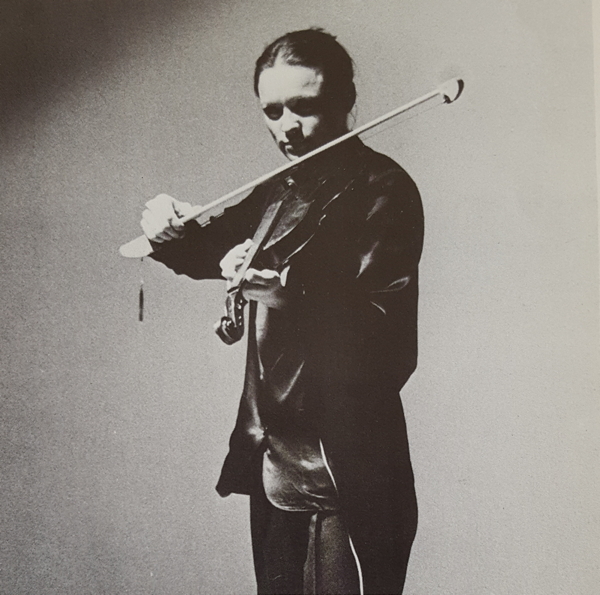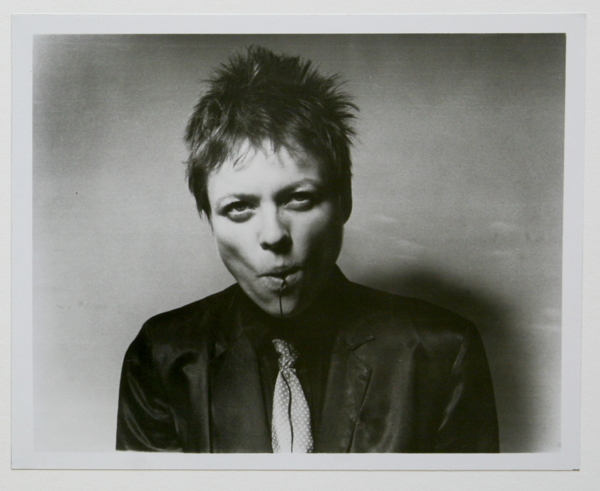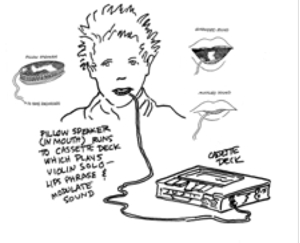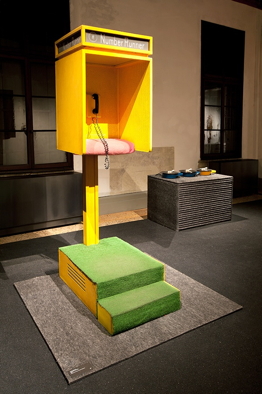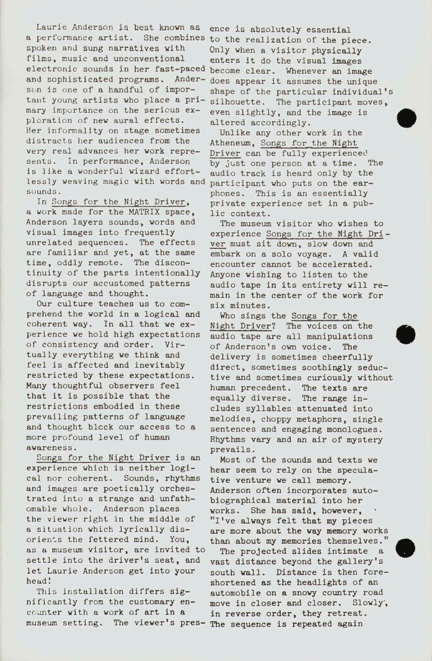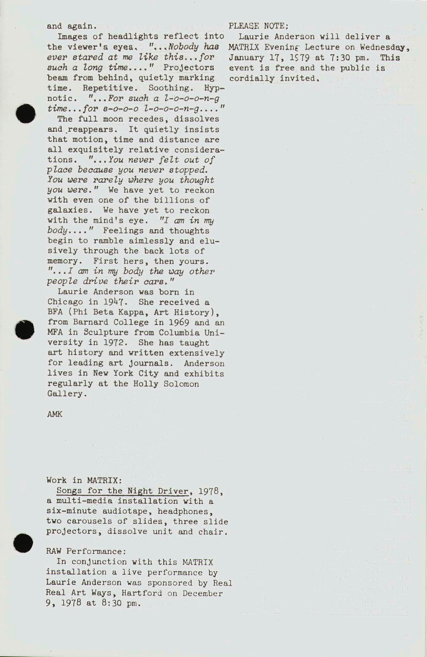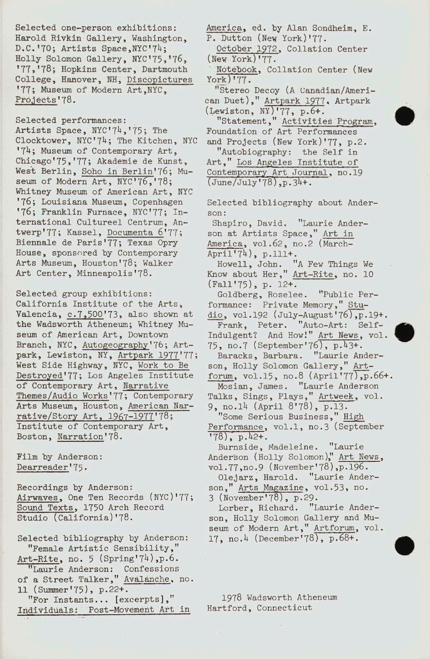listening, auditoria, audiences / écoute, auditeurs, auditoriums : — Studies —
AUDITORIAétude / studyEARLY WORKS (LAURIE ANDERSON)
|
|
Cette série explore les œuvres prenant la notion d'auditorium comme principe / This series is a study about works based on principles of auditoria. • COMPOSING THE NOW (Michel Waisvisz) - 2003 — read /lire • JULES VERNE - (Auditoires, Noise et Aventures Acoustiques / ''Audiences, Noise and Acoustic Adventures'') - XIX° — read /lire • BREATH (Gerald Shapiro) - 1971— read /lire • THE HANDPHONE TABLE (Laurie Anderson) - 1978— read /lire • LAURIE ANDERSON (Early Works 1971-1978)— read /lire • SIX SOUND PROBLEMS (Bruce Nauman) - 1968— read /lire |
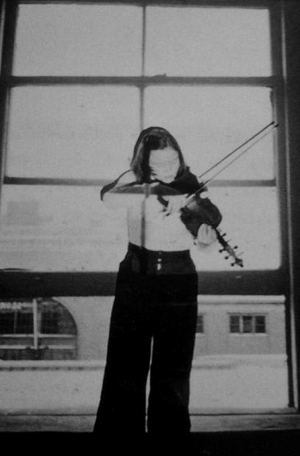
|
Page : — — [Introduction (in French)]
Pages : — — [The Handphone Table (1978)] — [Part 1 : 1971-1972] — [Part 2 : 1973-1974] — [Part 3 : 1975-1976] — [Part 4 : 1977-1978] — [Part 5 : 1979] —
Part 4 - 1977-1978 |
- ► 1977
- ► 1977 — Jukebox
- ► 1977 — It's Not The Bullet That Kills You (It's The Hole) (To Chris Burden)
- ► 1977 — Break It, (A film/song in 24/24 time)
- ► 1977 — Is anybody home ?
- ► 1977 — Art and Illusion, (A Film/Song in 24/24 Time)
- ► 1977 — Video Double Rock
- ► 1977 — Trophies
- ► 1977 — White on White, (A Song in 24/24 Time)
- ► 1977 — Stereo Song for Steven Weed
- ► 1977 — Quartet for Sol Lewitt
- ► 1977 — New York Social Life
- ► 1977 — Time to Go (for Diego)
- ► 1977 — Tape Bow Violin
- ► 1977 — Song for Juanita
- ► 1977 For Instants - Part 5 (Songs for Lines / Songs for Waves)
- ► 1977-78 — Notebook
- ► 1977 — Talking Pillow
- ► 1977 — Stereo Decoy : A Canadian-American Duet
- ► 1977 — Six Rooms
- ► 1977 — Acoustic Lens
- ► 1978
1977(Edit)
| -Received a grant from New York State Council on the Arts and the National Endowment for the Arts -Recorded several songs for "Airwaves" 110 records, New York and "New Music for Electronic and Recorded Media" -Spent two weeks not speaking in Buddhist retreat -Published stories in "Individuals" edited by Alan Sondheim -Shot slides and film on the road -Performed in many European avant garde music festivals |
1977 — Jukebox(Edit)
| — — Jukebox. Jan. 1977. Audiovisual installation. Holly Solomon Gallery, New York. The exhibition comprised twenty-four 45-rpm records in a jukebox and photo/text wall panels. — — Jukebox, Dec. 1983. Exhibition : Laurie Anderson, Works from 1969 to 1983: October 15-December 4, 1983, Institute of Contemporary Art, University of Pennsylvania |
 (Laurie Anderson, "Untitled", January 1977, installation : Holly Solomon Gallery, photo : Harry Shunk) Download a large picture |
— In 1977 Laurie Anderson developed her unique mix of popular and "serious" art further with an environmental-music piece at New York's Holly Solomon Gallery. Anderson hung illustrated song sheets on the wall and installed a commercial jukebox that was loaded entirely with her own songs and music. The musical style that Anderson takes on falls into the minimalist category with pop rhythms. She combines vocals, violin and electronic modifications of voice and music, just to name a few of her performance components. This results in a mix of minimal, new wave, spoken text and projected images. Her lyrics, while a necessary element, need music with them to make an effective impact.
[Such in Dearreader (1975) — à vérifier], Laurie Anderson showed a series of photographs coupled with texts at the Holly Solomon Gallery in New York. An unusual feature of the show was the presence of a large jukebox in the room : viewers could listen to songs available to be played on discs via the jukebox which contained twenty-four 45 rpm singles.
— — JukeBox was an exhibition of texts with photographs and 45rpm records in a juke box. At first the gallery was charging 25 cents for each song but there were a lot of complaints at the opening so after that they were free. Among the musicians on these early recordings are Peter Gordon on saxophone, Scott Johnson on guitar, Ken Deifik on harmonica, and Joe Kos on drums.
— — As Tom Johnson described the JukeBox installation in his Village Voice column in 1977, Laurie Anderson soon adapted the technology of permanence of music to her art. — (In Contemporary Musicians - Profiles of the People in Music, Vol. 1, edited by Michael L. LaBlanc, Detroit, MI : Gale Research, Incorporated, 1989)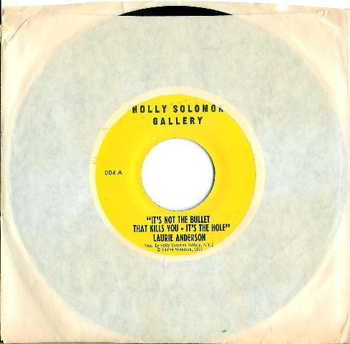 (Laurie Anderson – It's Not The Bullet That Kills You - It's The Hole / Break It - 45 rpm - Holly Solomon Gallery – 004, 1977 - The limited pressing of “It’s the Bullet That Kills You-Not the Hole”, was less than one hundred copies.) Jukebox 1 — Speak Softly but Carry a Big Stick : A Film Song in 24/24 Time (Turn the Other Cheek, but Carry a Big Stick) — (3:07) - [A phrase by Theodore Roosevelt] - [for a tape bow on pick-up violin] 2 — (The Window) The Wind -oh ! — (4:10) - [Film/song for voice and violin] 3 — Talk to Me (Lucille) — (3:00) 4 — Like a CB — (3:01) 5 — Break It — (4:37) - [Listen] 6 — Stereo Song for Steven Weed — (1:55) - [This song tells the story of Patty Hearst’s boyfriend being interviewed by two F.B.I. men.] - [This song is scored for two microphones and speakers on opposite sides of a small room] 7 — Files in the Eyes of a Baby — (4:03) 8 — Time to Go (for Diego) : A Film Song in 24/24 Time — (2:45) - [Listen] 9 — Man in the Empty Smoke [or : Man in the Empty Space - ?] — (4:40)- - [for voice, organ, percussion] 10 — New York Social Life — (3:20) - [Listen] 11 — Art and Illusion — (3:40) 12 — Is Anybody Home — (4:25) - [Listen] - [for boot horn, camera, stairs, piano, and voice, Peter Gordon: clarinet Joe Kos: drums Scott Johnson: bass Laurie Anderson: voice, violin] 13 — If You Can’t Talk About It, Point to It (For Screamin’ Jay Hawkins and Ludwig Wittgenstein) - or - (for Ludwig Wittgenstein and Reverend Ike) — (1:30) - [A quote from Ludwig Wittgenstein] - [one ninety-second composition featuring a stuttering vocal track modified by frequency shifting] 14 — Video Double Rock — (1:58) - ["Video Double Rock" poses and then solves the syncronization problem in an outrageous, yet oddly mundane audio-visual occurrence.] - [Laurie Anderson : "I usually watch TV in a rocking chair, and I have noticed as the chair moves, the image bends at the edges. A good solution is to put the TV in another rocking chair that is in sync, so that the image stabilises." A video composed for 2 violins that go in and out of phase.] 15 — One Day in Dallas — (5:29) 16 — Quartet for Sol Lewitt - [for four violins, from a drawing by Sol LeWitt used by Laurie Anderson to generate musical note values]{/cap} 17 — It's Not the Bullet that Kills You — It's the Hole - (A Reggae Tune for Chris Burden) [Listen] 18 — ? — Black Holes — or — Trophies {cap}19 — ? — From Photography and Good Design [The text of From "Photography and Good Design," 1977, begins as a cynical account of a love triangle, but ends in pathos.] — or — Tape Bow : ETHICS IS THE ESTHETICS OF THE FEW-TURE (Lenin) (two songs for tape bow violin) - [Listen] 20 — ? — Tape Bow : SONG FOR JUANITA (two songs for tape bow violin) - [Listen] 21 — ? — sh - [Voice, Tape [Thunder], Piano – Laurie Anderson] - [Listen] 22 — ? — Buy Buy Write : A Film Song in 24/24 Time 23 — Fast Food Blues - (3:34) - ["Fast Food Blues" was an interminably long song/ complaint about photo documentation. It included a recipe for disposing of your past. Just wrap it all up And blow it up to wall size.] 24 — Unlike Van Gogh - (2:50) - [Laurie Anderson : "it was a song called “Unlike van Gogh.” It was about that kind of writing because one of the reasons that I got fired—THE reason I got fired—from one of the jobs was because I made a point of mentioning van Gogh in all the reviews that I wrote because I just thought that his name should be in the foreground. I would just begin reviews, you know, with, “This artist, like van Gogh, uses yellow,” and then this editor finally said, “You know, not every artist can be usefully compared to van Gogh. Why don’t you take another tack on it?” So they all just started, you know, “This artist, unlike van Gogh, does this.” So I stopped writing after I was fired. I guess I really didn’t have a choice.] ? — Converse Song #5 (In Laurie Anderson, Works from 1969 to 1983: October 15-December 4, 1983, Institute of Contemporary Art, University of Pennsylvania, Catalog of the exhibition, 96 pages.) | Anyone who wandered into the Holly Solomon Gallery last month was confronted by, of all things, a jukebox. It was a big stereo model, all lit up in the usual way. If you pushed a few buttons, it would play any one of 24 singles by Laurie Anderson, and the day I was there you didn’t even need to feed it quarters. On the walls of the gallery were a number of wall hangings, also by Anderson. Most of them were first-person anecdotes, conveyed by a carefully lettered text and a photograph. Some of the wall hangings matched up with jukebox tunes, and some were independent. I had the feeling that the artist would probably have liked having a tune for every wall hanging, and a wall hanging for every tune, but that some of her ideas just didn’t quite lend themselves to both mediums. The singles on Anderson’s jukebox were in an artsy sort of semi-popular vein. Like most jukebox numbers, they were largely vocals, about three or four minutes long, and they generally conveyed a story or poem. But most of the other conventions of pop music were broken, if not completely ignored. Number 114, for example, was called New York Social Life (see below). Speaking voices expressed insincere concern for one another, made casual unspecified lunch dates, and generally carried on in a cool, frivolous way, against a background of unpleasant, raspy string sounds produced on a tamboura. In Unlike Van Gogh, number 143, Anderson related a personal story about working as an art critic. The music in the background includes a chant on the words of the title, a high plucking rhythm, and a bass line. Number 121 admitted a number of extraneous sounds, such as a boat horn and a parrot. Number 100 featured a talking jew’s harp that conveyed a text almost comprehensibly. Number 103, Like a CB lamented the intrusion of CB signals on home stereo equipment, and itself had a brief CB-type intrusion. Most of the songs had a personal, almost primitive touch in one way or another, but they were produced quite professionally. The stereo mix was often knowing, and Anderson sometimes overdubbed several vocal lines skillfully. Her violin playing came in several unusual forms, all of which she handled well, and she has real control over her singing when she wants to, as in number 102, Talk to Me (Lucille). She also made good use of Scott Johnson’s guitar and Peter Gordon’s sax on some numbers. There must have been an hour and a half of music in all, and since other gallery visitors kept selecting things I’d already heard, I could see that it could take all day to get through the complete repertoire. So I left before hearing everything, but not before gaining some clear impressions. Anderson is a good musician, and a good record producer, and though she seems to be steering a clear, strong path into a unique, semi-popular, semi-avant-garde area, she is also running into a dilemma. It has to do with one basic question: Is the gallery situation necessary to the music ? I began asking myself that question before I had even left the exhibit, and even after thinking about it for a couple of weeks, I’m not sure of the answer. I can’t help feeling, though, that the exhibit involved some contradictory motives, and I can’t help wondering just a little about the integrity of the project. If the art-gallery and jukebox situation is really necessary in order for the music to make its statement, then the music should not even be discussed except as a part of a multi- media exhibit, and it should certainly not be issued on an ordinary LP, as it apparently will be before long. On the other hand, if the music has its own integrity, then why bother to put it in a gallery situation? Why not just present it as music ? One can’t generalize about such things because so many works do function in more than one medium. Ballet scores become pure orchestral pieces, operas become record albums, books become movies, sculptures become theatre sets, and there is no reason why a gallery exhibit shouldn’t occasionally become a recording. Usually, however, works have to undergo a great deal of translating, revising, and adapting before they really come alive in a second medium. In Anderson’s case I sensed a bit of opportunism, an attempt to have it both ways, and I sense a bit of cynicism in my response. I just can’t stop suspecting that maybe the exhibit was a covert publicity stunt, an attempt to con us into noticing some music that we probably wouldn’t have paid much attention to in a more conventional presentation. And I can’t help feeling uncomfortable about having noticed. — (Tom Johnson, Laurie Anderson at the Holly Solomon Gallery, in The Village Voice, Feb. 28, 1977) — [Read the article] |
One of the things about the music in the work is first of all there is no classical bass line at all. The ground of this music is generally to establish a very monotonous beat, it’s a metronomic situation rather than a musical one ... almost all of these things have a pulse that’s very, very even and this then frees you to use real talking styles over that rather than being locked into a verse structure. So you can work outside of meter and use language the way it is used in an everyday sense, with all the stumblings and repetition and pauses and that kind of improvising with words. — (Laurie Anderson, “Interview with Bob George”, 1981) |
1977 — It's Not The Bullet That Kills You (It's The Hole) (To Chris Burden)(Edit)
— — 2 parts of the series of songs available to be played on discs (45 rpm single) via the jukebox machine at the Holly Solomon Gallery in New York for the Jukebox exhibition.
— — These two songs were released on 7"inch single by the Holly Solomon Gallery — [see above, JukeBox installation paragraph] — Ref : Holly Solomon Gallery / 004
— Side A : It's Not The Bullet That Kills You (It's The Hole) / Side B : Break It
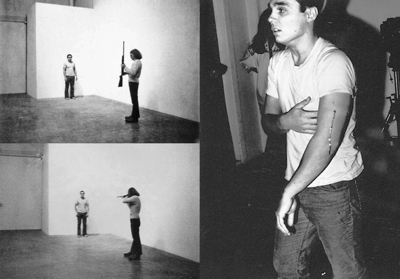 (Chris Burden, Shoot, 1971) “Shoot” (1971) consisted of the 25-year-old Burden being shot in the arm at close range by a friend wielding a rifle. A few inches off, and Burden would have probably died. Instead, as we see in the original piece below, he walks off very quickly, more in shock than pain. His intention was to be grazed by the bullet. It went a little deeper. — — [Watch a video with Chris Burden (New York Times)] — — [Video of the Chris Burden's performance - Shoot (1971) - Nov. 19, 1971] | Laurie Anderson, It's Not The Bullet That Kills You (It's The Hole) (To Chris Burden), 1977, (3:49) - Drums, Joe Kos - Guitar, Bass, Scott Johnson - Harmonica, Ken Deifik - Voice, Violin, Laurie Anderson From the lp Airwaves, One Ten Records 001/2, 1977 — — Before Laurie Anderson had a record contract, she released this - her first single [see above, JukeBox installation paragraph], apparently sponsored by the Holly Solomon Gallery for an installation (a jukebox containing this and a number of other songs including New York Social Life). The song was dedicated to Chris Burden. In 1977 Anderson released her first single, It's Not The Bullet That Kills You (It's The Hole) b/w Break It, in a limited run of less than 100, each packaged in an individually designed sleeve handmade by Anderson. Both songs had been featured in Jukebox, an exhibit at the Holly Solomon Gallery in New York. Anderson recorded the songs both at her home studio and ZBS Media, a studio in Fort Edward upstate New York, where she was artist-in-residence. — — The piece is a lightly chiding song, in reggae style, dedicated to the conceptual artist Chris Burden, whose performance of his own work which required a bullet to be shot into his arm exemplified an extreme posture (approaching a John Wayne-ish caricature) of the macho male artist of the present decade. If the song recalls the music of Kate & Anna McGarrigle, whose debut LP also came out in 1976, it might be the influence of Anderson’s friend and collaborator Roma Baran, who had just moved to New York from Montreal, where she used to play coffeehouses with the McGarrigles. |
La performance intitulée "Shoot" s’est tenue le 19 novembre 1971 au F Space de Santa Ana en Californie. Le court texte, très factuel, rendant compte de la performance s’énonce ainsi « À 19 heures 45, un ami m’a tiré dans le bras gauche avec une balle de 22 long rifle. Il se tenait à cinq mètres de moi. ». Seules deux images rendent compte de "Shoot". Sur la première, Chris Burden et son assistant se font face au moment où ce dernier s’apprête à tirer avec sa carabine ; sur la seconde, on voit le bras mutilé de l’artiste. Il existe également une brève vidéo relatant cette performance. Optant pour un montage peu spectaculaire, elle est composée de 3 plans : un générique précisant le contexte de la performance (date, lieu, nom de l’artiste), un écran noir de quelques secondes où l’on entend les bruits de la galerie F Space, puis un dernier plan tout aussi bref du tir de carabine. — [Source] | Lorsqu’en 1977, le 45 tours de Laurie Anderson sort chez Holly Solomon [voir ci-dessus, le paragraphe sur l'installation JukeBox], c’est une galette vinyle, audible sur n’importe quel Teppaz, extraite de Juke Box, installation audiovisuelle exposée dans la même galerie. L’artiste a composé 24 (vraies) chansons, la plupart écrites entre 1976 et 1977 pour des amis, qu’elle accompagne aux murs avec 24 notices et 24 partitions. La face A est dédiée à Chris Burden et s’intitule « c’est pas la balle qui te tue, c’est le trou ». L’œuvre est tout autant art qu’elle est chansonnette. Laurie Anderson a choisi dans l’extraordinaire profusion de la scène artistique la toute petite conjonction de coordination : et, oeuvre et musique, et installation, et scène, et art, et etc. A chaque forme correspond une diffusion particulière : du bac du disquaire à la salle d’expo, du musée à la scène, de la galerie à la page. Chaque forme juxtapose différents espaces émotionnels et correspond à des temporalités, à des qualités sensibles d’espaces et d’images matérielles et spirituelles, éminemment distinctes. En ce sens Laurie dépasse le vieil antagonisme qui oppose le générique et son contraire le spécifique. Elle contourne les 2 termes par une opération de bascule étonnamment simple : le récit. C’est en effet du « récit » qu’elle extirpe les catégories, esthétiques autant qu’idéologiques, et les traverse sans les nier mais sans les suivre non plus, indifférente à la théorie (trop désincarnée) ainsi qu’aux phénomènes de fusion (mashed potatoes). Conteuse, scénariste ou romancière (« All my families are storyteller » dit-elle) c’est du mot qu’elle tire toutes les ressources de l’expression pour arracher à l’étrange ce qu’il offre de plus résistant pour l’intégrer à une autre forme et lui donner une autre plasticité. — (Thierry Raspail - Source : http://archive.grame.fr/Biennale/MES2002/laurie.html ) |
It's not the bullet that kills you, it's the hole (A Reggae tune for Chris Burden) I used to use myself as a target I used myself as a goal I was digging myself so much, I was digging me so much I dug myself right into a hole Now, in a hole it's so dark You can't see a thing It's easy to loose sight of your goals It's not the bullet, not the bullet that kills you It's the hole, it's the hole, it's the hole... It's not the bullet it's the hole Like a ventriloquist I can throw [in ?] my voice Long distance is the story of my life In the words of the artist Joseph Boyce, "If you get cut, you better bandage the knife" Cause, in a hole it's so dark You can't see a thing It's easy to loose sight of your goals It's not the bullet, not the bullet that kills, you know It's the hole, it's the hole, it's the hole... Like a hole, like a black hole in space You disappeared and there's nothing to take your place Now I'm sweating, I'm freezin, in this Jamaican sea breeze, I remember you in my knees I really feel like fallin' It's not gravity that's getting me down It's giving me those down and out lowdown blues It's not the rain that's getting me wet, It's the holes, the holes in my shoes ! It's not the bullet, It's the hole Cause, in a hole it's so dark You can't see a thing It's easy to loose sight of your goals It's not the bullet, not the bullet that kills, you know It's the hole, it's the hole, it's the hole... It's not the bullet... It's the hole… [Source] |   | 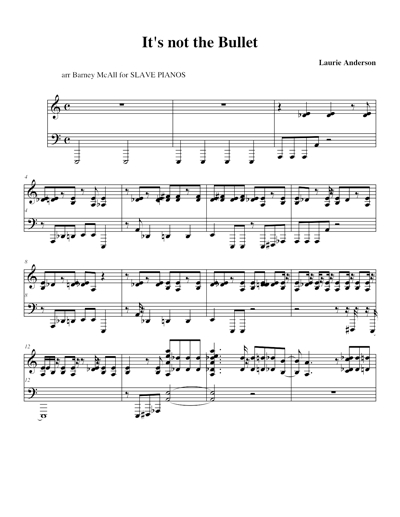 |
1977 — Break It, (A film/song in 24/24 time)(Edit)
| Break It (4:40) : The rarely heard B-side to Laurie Anderson's first single It's Not The Bullet That Kills You (It's The Hole), released on a limited run by the Holly Solomon Gallery in 1977 as part of her Jukebox installation there. The song is for saxophone, violin, guitar, mouth noises. Laurie Anderson - vocals and violin — Peter Gordon - saxophone — Scott Johnson - guitar — Ken Deifik - harmonica — Joe Kos - drums |
(Click to enlarge)
 | Break It (a film/song in 24/24 time), 1976 collage on paper 22 x 16 inches Collection of Thomas Solomon and John Solomon — [Source] |
1977 — Is anybody home ?(Edit)
— — part of the series of photographs coupled with texts (song sheets) at the Holly Solomon Gallery in New York for the Jukebox exhibition.
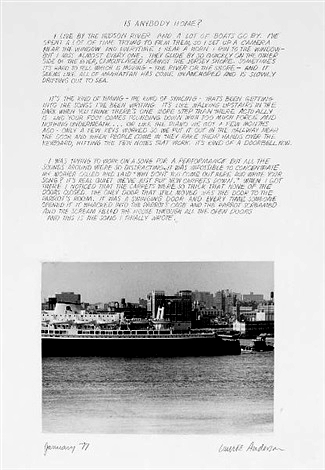 | Laurie Anderson, Is Anybody Home, 1976, 4:27 - for boat horn, camera, stairs, piano and voice Bass, Scott Johnson - Clarinet, Peter Gordon - Drums, Joe Kos - Voice, Violin, Laurie Anderson From the lp Airwaves, One Ten Records 001/2, 1977 |
Is Anybody Home ? (4:20) [talking] I live by the Hudson River, and a lot of boats go by They glide by so quickly Camouflaged against the Jersey shore Sometimes at night when the liners are lit up It's hard to tell which is moving, The boat, or the shoreline, And it seems like all of Manhattan has come unanchored, And is slowly drifting out to sea I spent hours trying to film them So I set up a camera by the window And every time I hear a horn, I run to the window But I usually miss them It's a kind of rhythm A kind of sinking that's been getting into the songs I've been writing lately Like walking up stairs in the dark And you think there's one more step then there actually is, And your foot comes pounding down With nothing underneath Or like the piano we got a few months ago Only a few keys work So we put it out in the hall near the door, And when people come in, they rake their hands across the keyboard playing the few notes that still work It's kind of a doorbell now All the sounds around were so distracting, I was trying to concentrate on a song for a performance, but I couldn't And my Mother called and said "Why not come out here and write your song ? It's real quiet, I've just put all new carpets down." [anybody home ? ] (repeated throughout next section) When I got there, I noticed that the new carpets were so thick that none of the doors closed. The only door that still worked was the door to the parrot's room. It was a swinging door, and every time someone opened it, It whacked into the parrots cage, And the parrot screamed, each time this happened Totally surprised dozens of times a day [...] | [...] And the shriek filled the whole house, Through all the half open doors. [violin starts] and this is the song, I finally wrote [sings] Some old birds, they never learn, Doors have hinges and they turn Water's wet, and fire burns, All good things are worth their weight And he who hesitates is late Some things can never be told What you got for free can never be sold Homes is where the heart is, Solid gold. Is anybody home ? Some new birds they never learn Doors have hinges and they turn Water is wet, and fire burns, What turns in turns out And what goes in goes out All good things are worth their weight And he who hesitates is late All good things are worth their weight Some things can never be told Home is where the heart is Solid Gold (various other lines repeated, with what goes up comes down added during fade out) [Source] |
1977 — Art and Illusion, (A Film/Song in 24/24 Time)(Edit)
— — part of the series of photographs coupled with texts (song sheets) at the Holly Solomon Gallery in New York for the Jukebox exhibition.
 | Art and Illusion, Film Song 24/24 Time (1977), [the title Art and Illusion is the same than the Ernst Gombrich's essay : "Art and Illusion - A Study in the Psychology of Pictorial Representation" published in 1961 — (E.H. Gombrich, Art and Illusion - A Study in the Psychology of Pictorial Representation", the A.W. Mellon Lectures in the Fine Arts, 1956, National Gallery of Art, Washington (Princeton: Princeton University Press, 1972)], combines a photography of a stuffed seal and hand-printed lyrics with an audiotape of her haunting refrain about the difficulties of separating art and reality. Laurie Anderson presented a seemingly mundane story about a student’s visit to a stuffed seal display at the Museum of Natural History. Accompanied by a photograph as well as her reaction, the written and tape-humorous words to a song/comment on the story, the viewer/listener was not able to expand his/her sensory experience. Art and Illusion Art and illusion - illusion and art - This is the song I’m singing in my heart. Art and illusion - illusion and art - Sometimes it’s hard to tel them apart. What is a real seal ? Or was it only art ? Art and Illusion, Illusion and Art. Are you really here ? or is it only Art ? Am I really here ? or is it only Art ? Art and Illusion, Illusion and Art. Sometimes it’s hard to tel them apart. |
1977 — Video Double Rock(Edit)
— — part of the series of photographs coupled with texts (song sheets) at the Holly Solomon Gallery in New York for the Jukebox exhibition.
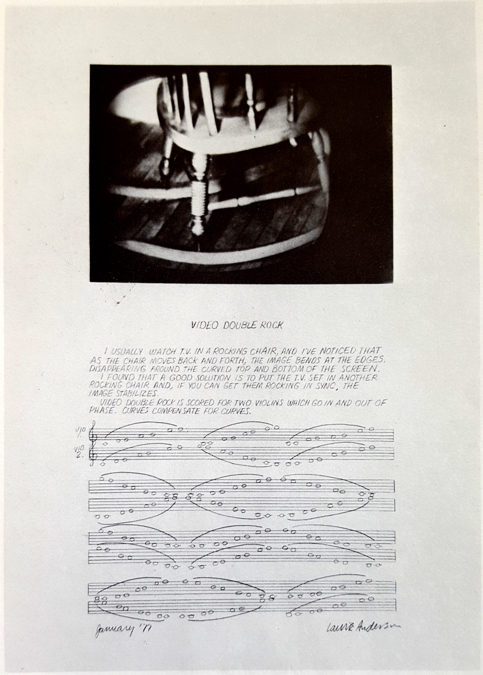 | Video Double Rock (1977) for two violins. |
1977 — Trophies(Edit)
— — part of the series of photographs coupled with texts (song sheets) at the Holly Solomon Gallery in New York for the Jukebox exhibition.
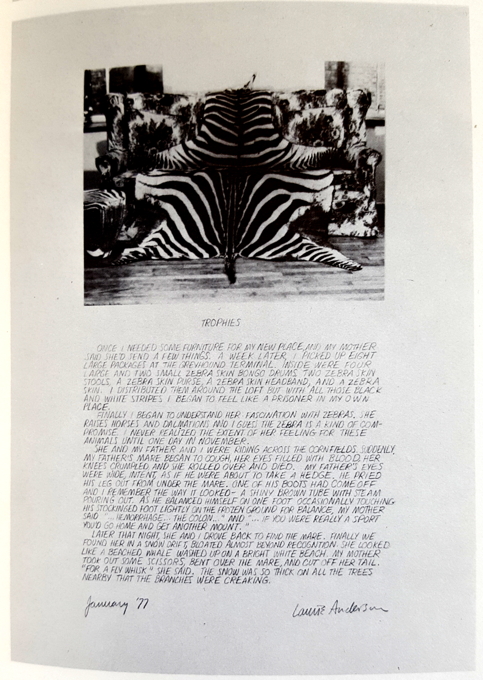 | Trophies (1977) |
1977 — White on White, (A Song in 24/24 Time)(Edit)
— — part of the series of photographs coupled with texts (song sheets) at the Holly Solomon Gallery in New York for the Jukebox exhibition.
(Click to enlarge)
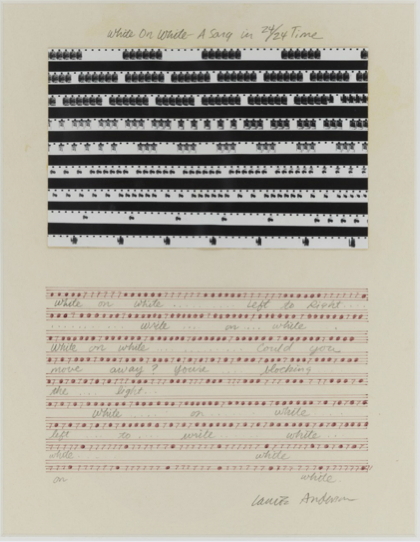 | White on White (a song in 24/24 time), 1976 collage on paper 13 1/2 x 10 1/4 inches Collection of Thomas Solomon and John Solomon — [Source] | Laurie Anderson, White on White, 1976, ? - for four violins and voice |
1977 — Stereo Song for Steven Weed(Edit)
— — part of the series of songs available to be played on discs (45 rpm single) via the jukebox machine at the Holly Solomon Gallery in New York for the Jukebox exhibition.
— — and part of the series of photographs coupled with texts (song sheets) at the Holly Solomon Gallery in New York for the Jukebox exhibition.
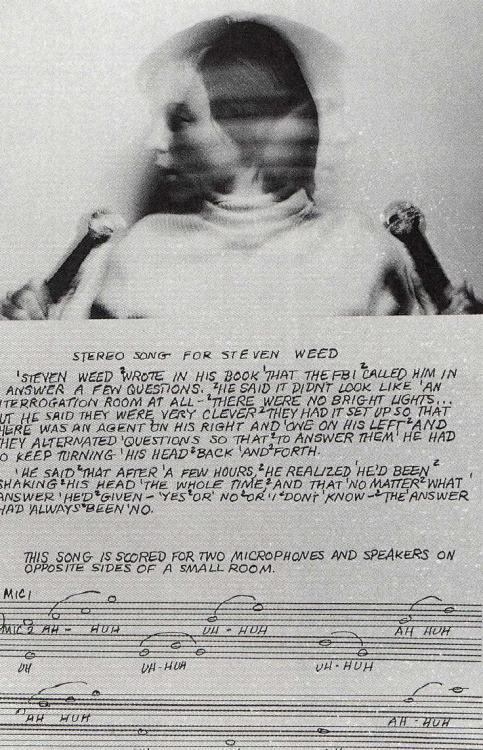 | This song tells the story of Patty Hearst’s boyfriend being interviewed by two F.B.I. men. Placed between them, he finds himself turning from one to the other to answer their questions. « He said that after a few hours, he realized he’d been shaking his head the whole time, and that no matter what answer he’d given - yes or no or I don’t know - the answer had always been no ». The song is scored for two microphones and speakers on opposite sides of a small room, and is accompanied by a photograph of Anderson looking two ways at once - [the photo superimposes two images to show Anderson, Janus-like, facing two opposite directions, speaking into two separate microphones]. Text, lyrics, photograph, score, and one’s image of « stereo » space begin to resonate as though they were all part of a harmonic mode with dissonant overtones. You get so wrapped up in thinking about Anderson’s dislocations of meaning that you can almost miss the fact that Stereo Song for Steven Weed is a powerful fable about passive resistance to interrogation. Gradually you begin thinking about the prevalence of interrogation in the modern world, about its importance on preserving ugly governments. Steven Weed becomes a parable of the future, when yes and no - in other words, one’s right to individuality - don’t matter any longer in a macroworld dominated by forces greater than human will. — (Kay Larson, Something Future, Something Past, In New York Magazine, July 23, 1984, pp. 48-49 ; and also : Kay Larson, The Patter of Little Feats, In New York Magazine, October 12, 1981, pp. 78 & 81) |
1977 — Quartet for Sol Lewitt(Edit)
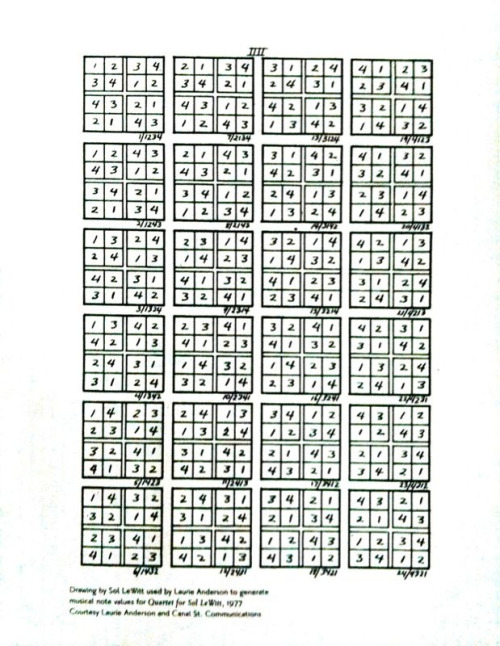 | Drawing by Sol LeWitt used by Laurie Anderson to generate musical note values for Quartet for Sol Lewitt, 1977 Laurie Anderson has used a variety of devices for creating scores, from a notated drawing to orchestration based on language and texts. — — "I composed Quartet for Sol Lewitt by assigning note values to numbers according to their placement in his drawing. The quartet is scored for four violins." — (Laurie Anderson) |
1977 — New York Social Life(Edit)
— — part of the series of songs available to be played on discs (45 rpm single) via the jukebox machine at the Holly Solomon Gallery in New York for the Jukebox exhibition.
from the LP New Music for Electronic and Recorded Media (1750 Arch S-1765), 1977
Recorded At – Studios Of Laurie Anderson
| Laurie Anderson, New York Social Life, 1977, 3:21 Tambura, Scott Johnson - Voice, Performer [Telephone], Laurie Anderson From the lp New Music For Electronic And Recorded Media, 1750 Arch Records – S-1765, 1977 |
| New York Social Life is a song about life lived on the telephone, says Anderson, and includes her droning listlessly, "Oh, hi, sure, let’s get together, let’s have lunch…" One of the earliest Anderson pieces New York Social Life (which was later incorporated in United States) exemplifies many of the traits of the New York conversational style (fast rate of speech ; fast rate of turntaking ; persistence - if a turn is not aknowledged, try, try again ; marked shifts in pitch ; marked shifts in amplitude ; preference for storytelling ; preference for personal stories ; tolerance of, preference for simultaneous speech ; abrupt topic shifting) in an apt parody of New Yorker’s speaking style which creates instant involvement through fast, formulaic talk, overlapping talk and repetition of newly used phrases. However, in the performance frame, speaking to the audience, Anderson often creates involvement through the opposite means : slow tempo of speech and extensive use of silence. In interpersonal communication between two or more people in the literal or ordinary frame, inter-run pauses may signal conversational disfluency or they can be used strategically by speakers to gain conversation status. But speaking to her audience in the performance frame, Anderson can afford to produce long silences with little threat to disrupt the flow of her talk. — (Adam Jaworski, Silences in Laurie Anderson’s performance art, In Silence : Interdisciplinary Perspectives, edited by Adam Jaworski, Berlin / New York : Mouton de Gruyter, 1997) |
New York Social Life Hi ! How are you ? Where’ve you been ? Nice to see you. Listen, I’m sorry I missed your thing last week, but we should really get together, you know, maybe next week. I’ll call you. I’ll see you. Bye bye. […] Listen, Laurie, uh, if you want to talk before then, uh, I’ll leave my answering machine on… and just give me a ring… anytime. | These excerpts from New York Social Life focus less on the outrage of what is evidently an awkward discourse painfully aware of its own compulsion toward insincerity, what is a wavering between sympathy and selfishness, than on the superficiality of conversation as a slick surface of ready-made signs or gestures used to break off or establish contact quickly. It is what is business is called « one minute management ». — (Herman Rapaport — Can you Say Hello ? - Laurie Anderson’s United States, In Between the Sign & the Gaze, Cornell University Press, 1994{/cap} |
1977 — Time to Go (for Diego)(Edit)
— — part of the series of songs available to be played on discs (45 rpm single) via the jukebox machine at the Holly Solomon Gallery in New York for the Jukebox exhibition.
Time to Go (for Diego) (1977)
from the LP New Music for Electronic and Recorded Media (1750 Arch S-1765), 1977
Recorded At – Studios Of Laurie Anderson
| Laurie Anderson, Time to Go (for Diego), 1977, 2:45 Guitar, Organ, Scott Johnson - Voice, Violin, Laurie Anderson From the lp New Music For Electronic And Recorded Media, 1750 Arch Records – S-1765, 1977 |
Time to Go (for Diego) Diego used to be a guard at the Museum of Modern Art. He was on the night shift. His job was to go around the museum and tell people to leave. Or, as he put it, 'Snap them out of their art trances.' People who'd been standing in front of one thing for hours, he would jump in front of them and snap his fingers, and he'd say, 'Time to go.' Time to go. Time to go (repeat) | Laurie Anderson's New York Social Life and Time to Go (for Diego), both from 1977, are early examples of Anderson's anecdotal critiques of American culture. Time to Go (for Diego) is for voice, guitar, keyboards and is one of Laurie Anderson’s earliest story-based sound pieces and was dedicated to art curator, musician, and No Wave pioneer Diego Cortez. The first half of the song was dialogue by Anderson, interupted regularly by a bit of guitar playing, disolving into both guitar and violin as Anderson repeats "Time to go". |
| Anderson writes, Time to Go is part of a series I’m doing called ‘It depends on who you’re talking to,’ which centers on saying the same thing to various people and working with the slight changes in inflection and tone that result. . . . I tried to stabilize melodic lines and use irregular pauses to imitate Diego’s clearing-out tour-duty of the museum.” Indeed, the biting quality of the guitar track very effectively parallels the verbal image of Diego snapping his fingers at the museum visitors to rouse them out of their “art trances.” |
1977 — Tape Bow Violin(Edit)
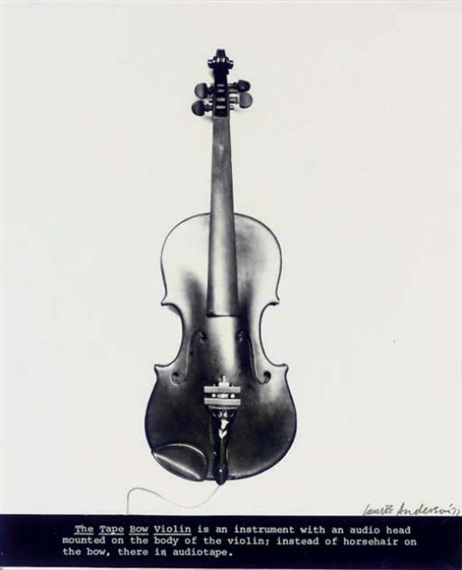 | — — I had been on an Indian reservation, at a place in Canada. There was a place called Corner Restaurant, and there were no corners on the reservation and no streets, you know. But it’s one of those adapted sort of things, and in the restaurant there was a jukebox and in the jukebox there was only one record which was one that was popular at the time, George McCrae’s “Rock Your Baby.” The Cree kids knew the song completely but with the weirdest kind of phrasing. They just learned it right off the record. I got real interested in that kind of tension between parodying something and swinging with it, so I made a film about that actually, about that jukebox, which is an animated crossword puzzle of various ways of spelling the lyrics to that song and the way they would leak into other meanings, like “Rock you, rock you”… so that the sound itself became very non-specific and it could be plugged into any number of meanings. The soundtrack for that was using this violin voice thing so that is was a kind of parallel situation of enunciated things with the tone coming from somewhere else. That particular way of using sound is a lot like the things I’ve been working with recently, the tape-bow violin, which is an instrument that has an audio head mounted on the body of the violin. |
Question : One audio head ? — — One audio head, with stereo and running into a little preamp. Instead of horsehair on the bow, there is audio tape so that the dynamics of bowing then are really emphasized and it’s really a back and forth process. I would make a lot of tapes in strips and then listen to them backward, you know, back and forth, and the first time that I was working with “wha” sounds, like “who are you ? Who is there ?”… and I was playing them backward and I started hearing all sorts of really interesting verse-reverse things. I heard very plainly on one of the tapes “Lao Tse” which was the backward sound version of “who is there ?” It goes one way and then “Lao Tse” for some reason goes the other. It works very well bilingually because of the inflection. “Who are you ?” is “Juanita” backward. Well, especially languages that have a lilt at the end you know, “Juanita,” or “Lao Tse,” you know, anything that kind of comes up at the end. I mean, it doesn’t work anything like palindromes that are written backward situations. So I was thrilled to hear “Lao Tse” because I’d just been reading about a conversation that he had been having with another philosopher about whether it’s better to see or to hear, a real esoteric and totally un-resolvable conversation which he finally ended by saying, “Well, seeing your face is not as good as hearing your name.” So when I heard that name coming through, it was very exciting. When I do a performance somewhere else, I would record, say, a lot of German phrases, going this way and then it would be English coming back the other way. [...] Those [...] performances [(such as those with the Tape Bow Violin)] actually were pretty much based on things that had happened to me in a sort of distant past. — (Laurie Anderson, Interview by Kate Horsfield and Lyn Blumenthal, 1977, published Apr. 2006, Fnews, The School of the Art Institute of Chicago) |
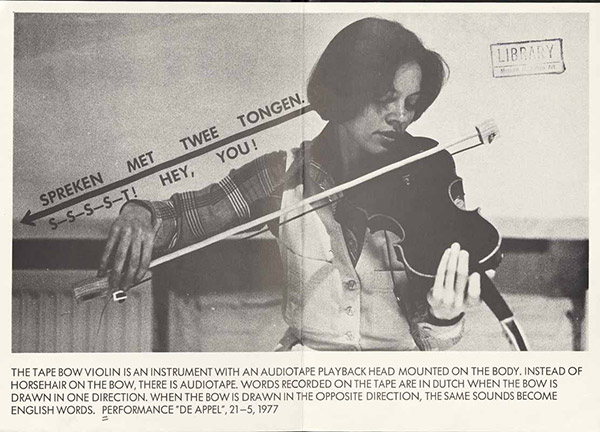
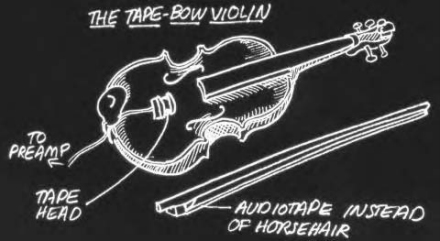
1977 — Song for Juanita(Edit)
— — ? — part of the series of songs available to be played on discs (45 rpm single) via the jukebox machine at the Holly Solomon Gallery in New York for the Jukebox exhibition.
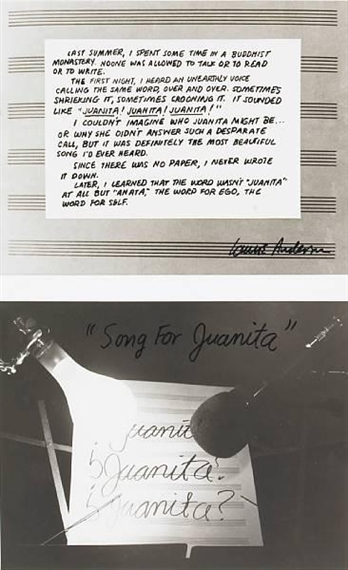 | Laurie Anderson, Song for Juanita, 1977, ? - for Tape-bow violin, voice and piano (Laurie Anderson). - (St. Marks Church, NYC, May 18, 1977) From the lp Airwaves, One Ten Records 001/2, 1977 — — [With the Tape Bow Violin] I would make a lot of tapes in strips and then listen to them backward, you know, back and forth, and the first time that I was working with “wha” sounds, like “who are you ? Who is there ?”… and I was playing them backward and I started hearing all sorts of really interesting verse-reverse things. I heard very plainly on one of the tapes “Lao Tse” which was the backward sound version of “who is there ?” It goes one way and then “Lao Tse” for some reason goes the other. It works very well bilingually because of the inflection. “Who are you ?” is “Juanita” backward. Well, especially languages that have a lilt at the end you know, “Juanita,” or “Lao Tse,” you know, anything that kind of comes up at the end. I mean, it doesn’t work anything like palindromes that are written backward situations. — (Laurie Anderson, Interview by Kate Horsfield and Lyn Blumenthal, 1977, published Apr. 2006, Fnews, The School of the Art Institute of Chicago) Song For Juanita was composed in 1977 for tape-bow violin, voice and piano. It begins with a voice recalling a summer spent in a Buddhist monastery. The narrator explains how she heard a voice in the night saying “Juanita”, which she later realized was “anata”: a word that means self. Throughout the work, there is a soft, meditative piano motif. At one point in the piece, a syllable of “Juanita” – “juan” – is played and reversed to say “no one no one”. There is a soft speaking voice in addition to the manipulated one, which creates a subtle, playful counterpoint. Through her attention to song structure, sound and the spoken word, Anderson strikes a delicate balance between narrative and form, experimentation and craft. |
1977 — Ethics is the Esthetics of th Few…ture (Lenin)(Edit)
— — ? — part of the series of songs available to be played on discs (45 rpm single) via the jukebox machine at the Holly Solomon Gallery in New York for the Jukebox exhibition.
One of the statements that I was especially interested in at the time was something that Lenin said : "Ethics is the esthetics of the future," which, I thought, could be understood in at least two ways. [With the Tape Bow Violin] Lenin's aphorism "Ethics is the esthetics of the future" became, ironically, "Ethics is the esthetics of the few" when I stopped the bow just short of the last syllable. — (Laurie Anderson) |
Ethics is the Esthetics of th Few…ture (Lenin) (1977)
from the double LP Airwaves (One Ten Records – OT 001/2), 1977
Under the title : Two Songs For Tape Bow Violin : Ethics Is The Esthetics Of The Few-Ture (Lenin) / Song For Juanita
1977 For Instants - Part 5 (Songs for Lines / Songs for Waves)(Edit)
—— from FOR INSTANTS - Part5, The Kitchen, NYC, April 23-24, 1977
—— from FOR INSTANTS - Part5, De Appel, Amsterdam, Holland, May 21, 1977
—— from FOR INSTANTS, Arte Fiera, Bologna, Italy, 1977
—— FOR INSTANTS-CONTINUED, Otis Art Gallery, Los Angeles, CA, 1978
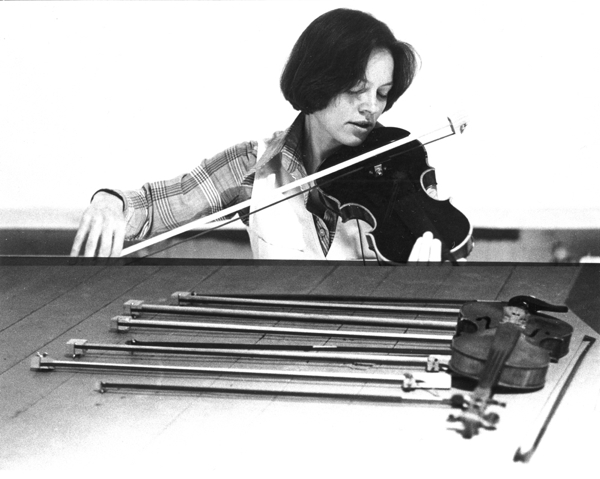
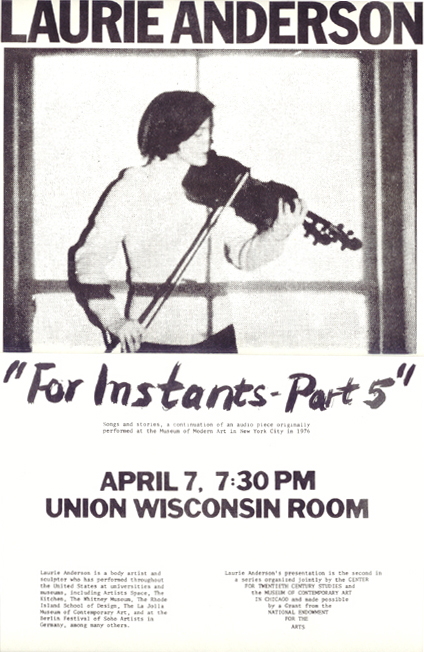
For Instants- Part 5, Amsterdam - De Appel, 1977-05-21
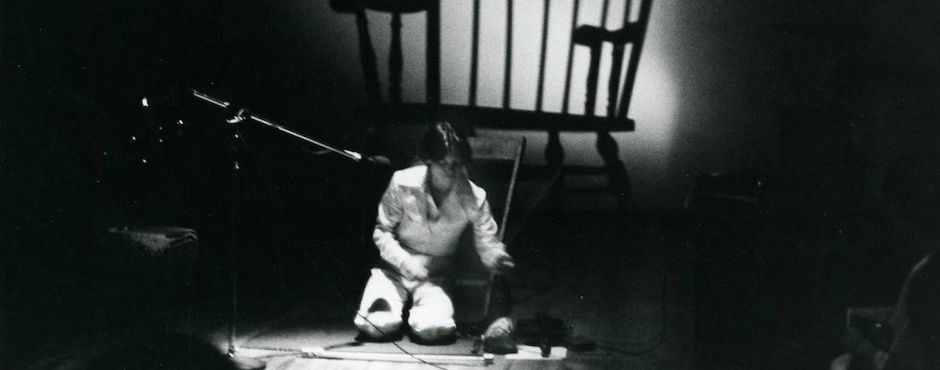
The Kitchen - For Instants Part Five - 1977-04-23
| Laurie Anderson. Songs for Lines/Songs for Waves. 1977. Film-video performance. The Kitchen, New York In this work Anderson explored the connections between classical music and a cacophony of industrial sounds. She premiered For Instants 5 (Songs dor Lines/Songs for Waves) at the Kitchen. Using the strong bass line and percussion beat of rock as the musical underpinnings for her narrative, and video images on a large screen to reinforce the story line, Anderson’s performance received enthusiastic reviews from art and music critics alike. Laurie Anderson’s Songs for Lines / Songs for Waves all have humorous lyrics pertaining to ethics, aesthetics, and other social phenomena. |
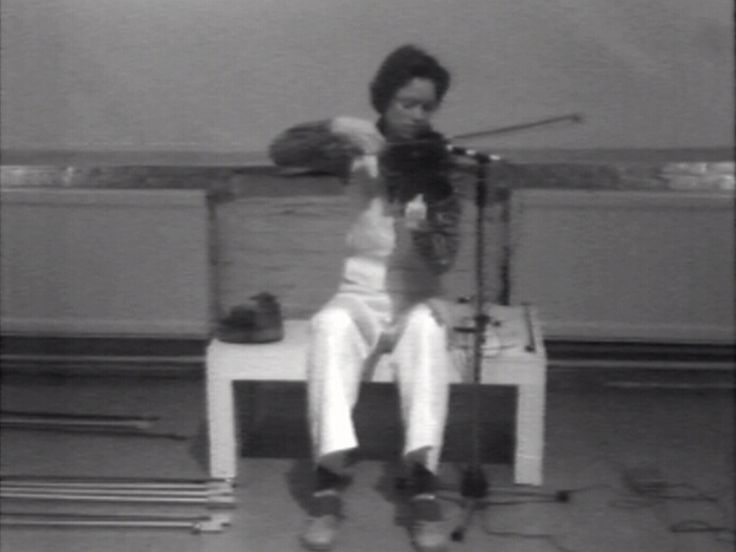 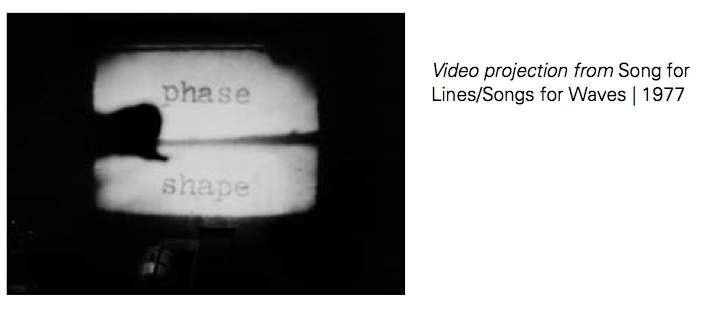 | This performance consists of ten songs (38'56'') in which music, language and images are equally important. In most of these songs, Anderson plays the violin, accompanied by her own singing and an audiotape (with spoken text, more singing or more violin music). Some of the text for Songs for Lines / Songs for Waves was played backward and forward : she reversed recorded words, exposing the arbitrariness of signifiers. Her songs are often combined with a film projection : she is framed by the light from the projection, and is playing with the shadows cast by her body and her violin. Anderson makes experimental music, and she often find solutions in technological inventions, as with the song 'a man, a woman, a house and a tree'. The music for this piece is created with the help of a ‘slow-scan’ machine, which registers visual information and transforms this into sound. These experiments are not only about music, but also about language: anagrams, play on words and poetic stories. The introductory anecdotes that Anderson tells are just as important as the song itself. Anderson also uses the tape bow violin, developed by Bob Bielecki and herself. This violin is modified in such a way that the traditional horsehair strings of the bow have been replaced by a piece of audiotape, on which spoken texts and other sounds have been recorded. For the performance at De Appel, Anderson incorporated fragments of Dutch proverbs and sayings in her ‘tape bow’, as well as Lenin’s famous statement 'Ethics is the aesthetics of the future', which she plays in such a way that it sounds as follows: 'Ethics is the aesthetics of the few'. The movements of the bow visualize language in time. The linearity of the language literally reappears in the linearity of the bow. — [Source] — — "For me the violin is the perfect alter ego. It's the instrument closest to the human voice [...] I've spent a lot of time trying to teach it to talk. [...] Because the bow is drawn both ways, I got interested in backward sounds. [...] So I made a lot of songs that could be played both ways." — (Laurie Anderson) —— [Access to another Song for Lines video] |
1977-78 — Notebook(Edit)
— — Notebook, Artist Book Series #1, New York City, USA : Collation Center (& Wittenborn Art Books), 1977 — 47 pp., 14 x 18 cm, b&w.
| — Laurie Anderson's Notebook consists of scores, scripts, photos, and anecdotes from four performances, arranged in a collage of before and after thoughts. — Anderson's second artist book documents compositions for electronic violin performed in various ourdoor city spaces. The contents include Film/song in 24/24 time, Duets on ice, Two songs for violin and projector, Duet for door jamb and violin, etc. |
| Cette œuvre de Laurie Anderson, Notebook, se compose de partitions, manuscripts, photos et anecdotes pris de quatre performances, et arrangées dans une sorte de collage d’avant- et d’arrière-pensées. |
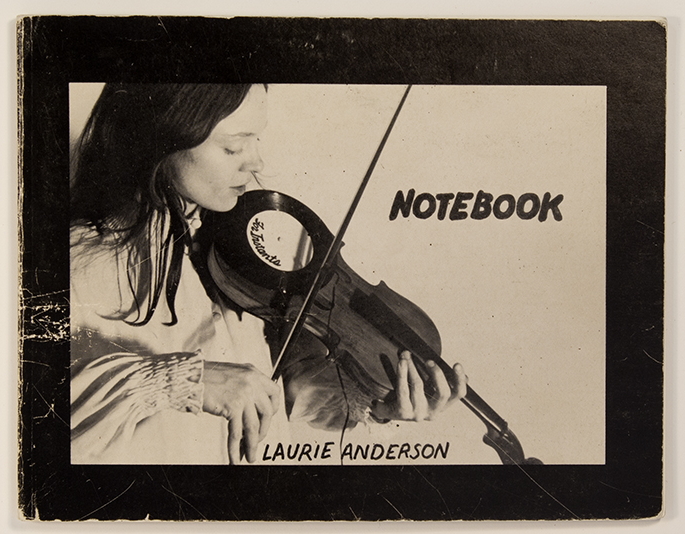
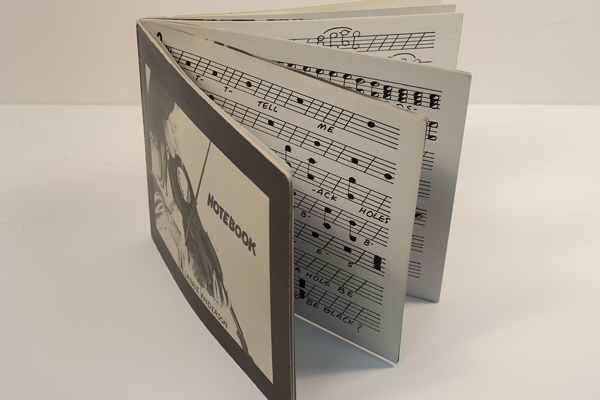


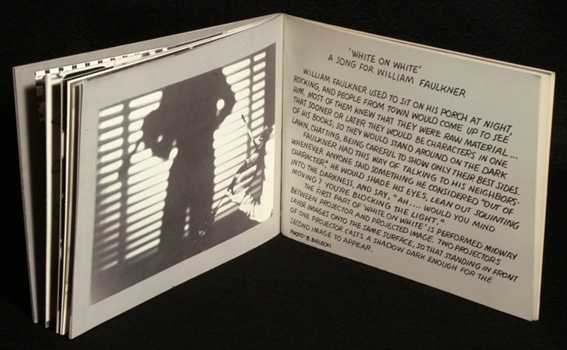

1977 — Talking Pillow(Edit)
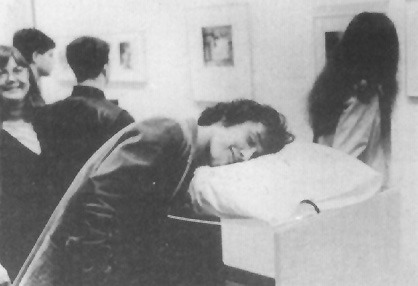 | The piece featured pillows with speakers inside. The piece invites the viewer to place their head on a pillow on a pedestal. A recording starts and it is Anderson herself, recounting dreams she had. The idea for the Talking Pillow came from a commercially available language-learning system that promised to « teach German as you sleep ». Laurie Anderson used the device to record stories about insomnia. — — “In this dream I’m on a tightrope tipping back and forth and trying to keep my balance. And below me are all my relatives and if I fall I’ll crush them,” she intones. "This long thin line, the song line, the shout, this tightrope made of sound – the only thing that binds me to this turning world, made of my own blood... Remember me is all I ask and if remembrance be a task, Forget me..." |
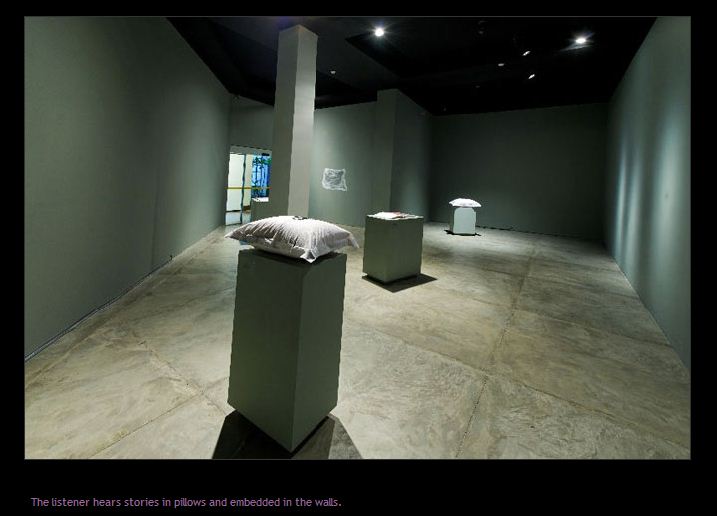 | Talking Pillows at the Barbican, London for the collective exhibition "Laurie Anderson, Trisha Brown, Gordon Matta-Clark – Pioneers of the Downtown Scene, New York 1970s", 3 March – 22 May 2011, Barbican Art Gallery |
1977 — Stereo Decoy : A Canadian-American Duet(Edit)
— — Art Park, Levinston, New York — commissioned by Artpark for outdoor work by artists programme
| Stereo Decoy, Materials : piano, violin, walkie-talkie, audiotape, bullhorn, speakers, generator, mixer and microphone. A monumental project, Stereo Decoy : a Canadian-American Duet which sees a piano suspended on a crane across the River Niagara. Stereo Decoy was a duet for tape and live sound. On the Canadian side of the Niagara River there was a tape piece for violin and piano. On the American side the duet was live. The idea was that the sounds would ricochet back and forth across the gorge, back and forth across the border. Out of control. The bass rolling in magnificent waves, the treble bouncing everywhere. |
| Un projet monumental, Stereo Decoy : a Canadian-American Duet, qui propose un piano suspendu à une grue au-dessus des Chutes du Niagara. Stereo Decoy était un duo pour sons en direct et sons enregistrés. Du côté canadien du fleuve il y avait un enregistrement pour violon et piano qui était diffusé. Du côté américain le duo jouait en direct. L'intention était que les sons pouvaient ricocher d'un côté et de l'autre de la gorge, d'un côté et de l'autre de la frontière. Hors de tout contrôle. Les sons graves roulaient dans la gorge comme des vagues magnifiques, et les sons se répercutaient partout. |
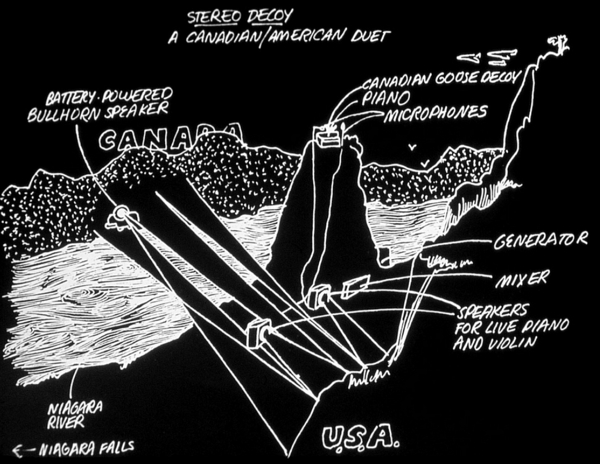 (Stereo Decoy : A Canadian-American Duet — Sketch for piano performance on a ridge overlooking the Niagara River, 1977) | 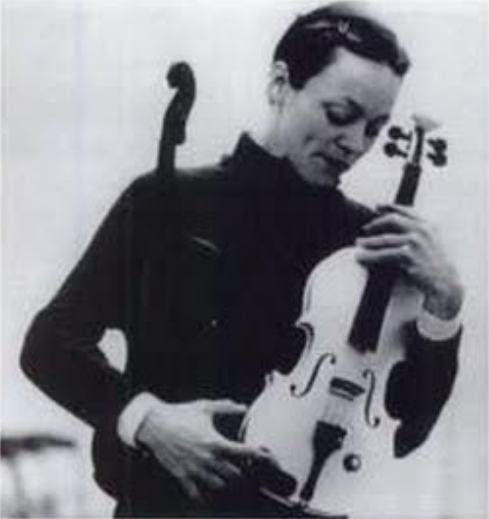 (Laurie Anderson in Bâle, Switzerland, 1977) |
1977 — Six Rooms(Edit)
Six Rooms, a Proposal — Collection Musée National d'Art Moderne - Centre Georges Pompidou - Beaubourg, Paris.
- Place / Space (From "Six Rooms", a Proposal)
- Video Duet (From "Six Rooms", a Proposal)
- Seventeen Stereo Story - Songs, (From "Six Rooms", a Proposal)
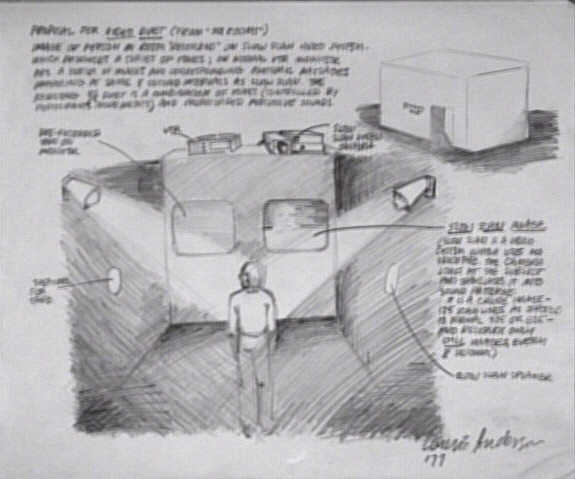
1977 — Acoustic Lens(Edit)
— — Moore College of Art, Franklin Institute, Philadelphia, 1977-78
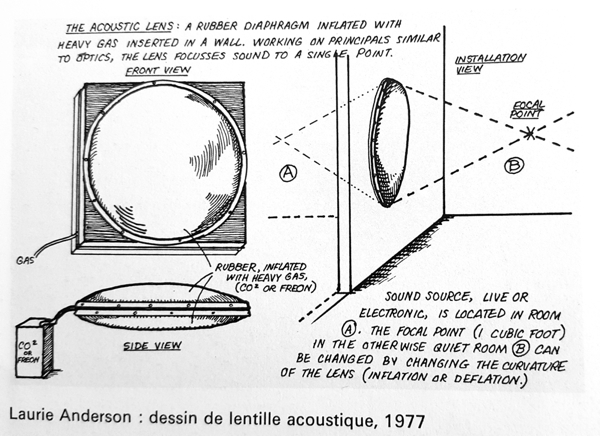 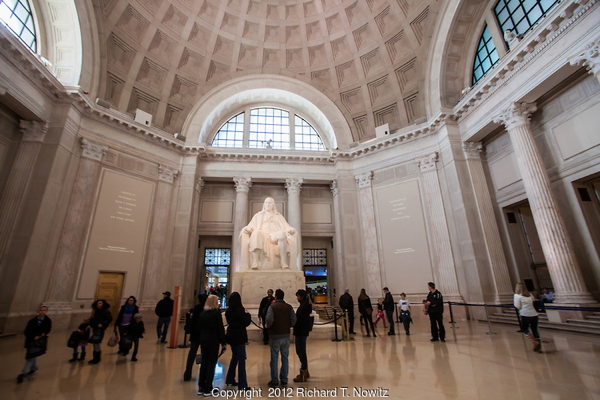 | — — Lastly sounds can be conveyed through gases. In 1977 Laurie Anderson inserted a rubber diaphragm inflated with heavy gas in a wall. The acoustic lens works on principals similar to optics, the lens focuses sound to a single point. The focus point of the sound can be changed by inflating or deflating the lens and in that way adapting the curvature of the lens. —(R. Block et al., 1980) — — Laurie Anderson designed an acoustic lens at the Franklin Institute in Philadelphia. Bielecki constructed a sphere made out if a thin latex material. It was inflated with CO2 and inserted in a wall between two rooms. [One room contained a tape player which played a recording of a person whispering slogans by Benjamin Franklin. The other room, containing a statue of Franklin, was silent.] Sounds from one room were played through the sphere that focused them to a spot in the other room. [Working on optical principles, the lens focused the sound from the tape player to the exact point in the other room at which a viewer would encounter the statute of Franklin. The viewer would stand near the statue, with no loudspeaker visible, and hear the whispered slogan. The focus point of the sound can be changed by inflating or deflating the lens and in that way adapting the curvature of the lens.] Bob Bielecki once confided to me that it didn’t work too well but the idea was there. — (Alvin Lucier, In Music 109 : Notes on Experimental Music, Middletown, Connecticut : Wesleyan University Press, 2012, Chapter 10 - Lenses, Intervals ; Laurie Anderson, Stories from the Nerve Bible, New York : Harper Perennial, 1994 ; Judy Donaway, My Beautiful Balloon, Part 1, in Musicworks 81, Fall 2001, pp. 14-21 ; Laura Maes, Unraveling the mystery: the creative use of natural phenomena in sound art, In ARTECH 2008, Proceedings of the 4th International Conference on Digital Arts, 7- 8 November 2008, Edited by Alvaro Barbosa, Portuguese Catholic University, Porto, p. 29)) — — Acoustic Lens, Moore College of Art, Philadelphia 1978 : "While we were working on the project, we wandered around Philadelphia looking for a place to install the lens. We stopped at the Franklin Institute, the museum that houses a huge walk-in heart with amplified heart." — (Laurie Anderson) |
1978(Edit)
| -Worked as a migrant cotton picker with the Taylor family near Covington, KY -Met Mister Spoons -Wrote NOTEBOOK, a collection of scores and stories -Lived in Berlin -Performed at the Nova Convention; met William S. Burroughs -Performed a series of pieces in Europe and the United States -Did sound and visual installations at various galleries and museums in the United States and Europe -Visited Benedictine Convent in Wisconsin to conduct a seminar with nuns on the spoken word -Worked as a straight man for Andy Kaufman in comedy clubs and Coney Island -Taught at Cal Arts, Valencia, California |
1978 — Handphone Table(Edit)
| — Merci d'accéder directement à cette page consacrée à une étude sur The Handphone Table — — please read this page about a study on The Handphone Table 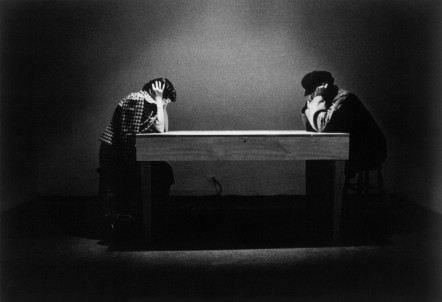 |
1978 — Cassette in Mouth (The Pillow Speaker)(Edit)
| In 1978 Laurie Anderson used The Cassette in Mouth, a small audio cassette of violin recordings [plays while] that she puts [a small loudspeaker] in her mouth so that she can modify the dynamics and phrasing by varying the speed with which she opens and closes her lips. — (Jacqueline Caux, Laurie Anderson Brings Out Her Violins / Les Violons de Laurie Anderson, In Art Press nr 285, [Source (pdf)]) |
| En 1978, Laurie Anderson utilise ''The Cassette in Mouth', petite cassette d’enregistrements de violon [lu par un lecteur cassette et connecté à un petit haut-parleur] qu’elle introduit dans sa bouche et dont elle nuance la dynamique et le phrasé en ouvrant et en refermant plus ou moins rapidement les lèvres. — (Jacqueline Caux, Laurie Anderson Brings Out Her Violins / Les Violons de Laurie Anderson, In Art Press nr 285, [Source (pdf)]) |
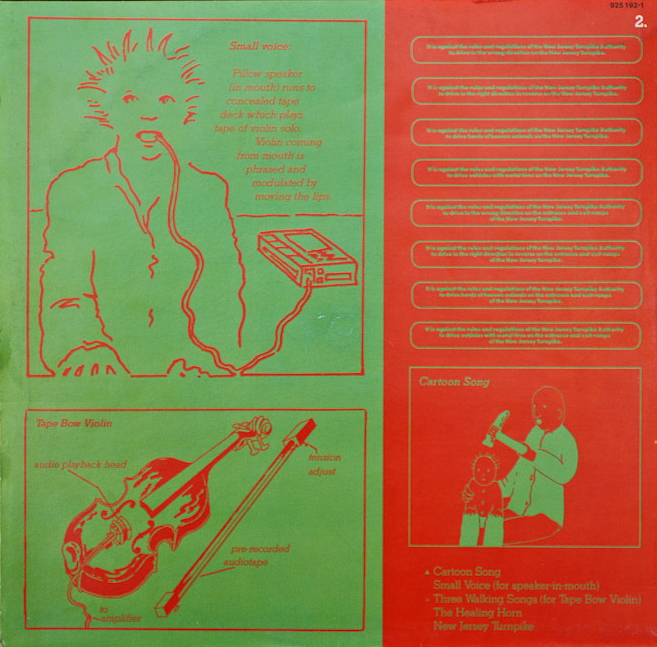 | Small voice Pillow speaker (in mouth) runs to concealed tape deck which plays tape of violin solo. Violin coming from mouth is phrased and modulated by moving the lips. |
Laurie Anderson performs a short song with a pillow speaker, in 2012 at the School Of Visual Arts, NYC.
1978 — Quartet for Four Listeners(Edit)
— — Laurie Anderson- Quartets For Four (Subsequent) Listeners - Holly Solomon Gallery, New York - September 9-September 30, 1978
 | Laurie Anderson’s acoustical installation - Quartet #1 for Four (Subsequent) Listeners, 1978 - inverts Rauschenberg’s procedure by having lights trigger sounds. A small gallery room is rigged with four large loudspeakers suspended in a diagonal row along the ceiling with four spotlights installed in a corner and four cylindrical light sensors hung in line among the speakers. In the darkened room a diagonal ribbon of light on the floor directs gallery visitors. The words ’note’ and ‘tone’ are printed on the floor at each end of the room. When a visitor blocks the light, he/she activates four sounds : a repeated monosyllable, a violin phrase , a woman’s voice softly humming, and a sound that is either traffic or surf. ln some ways suggestive of participatory theatre, Quartet #1 for Four (Subsequent) Listeners is programmed for social interaction. The installation invites the anonymous observer/auditor to perform acts of sensory engagement, which disrupt patterns of perception. For every action there is a prerecorded aural reaction in Laurie Anderson's installation. The piece is both engaging and entertaining. |
1978 — Doormat Love Song(Edit)
—— and/or, Seattle, June 6-14, 1978
| Laurie Anderson built a palindrome door for an installation at and/or Seattle, in 1978. As the door was opened or closed the Door Mat Love Song audio tape on the floor was played by a tape head under the door. The song was heard forward and backward. |
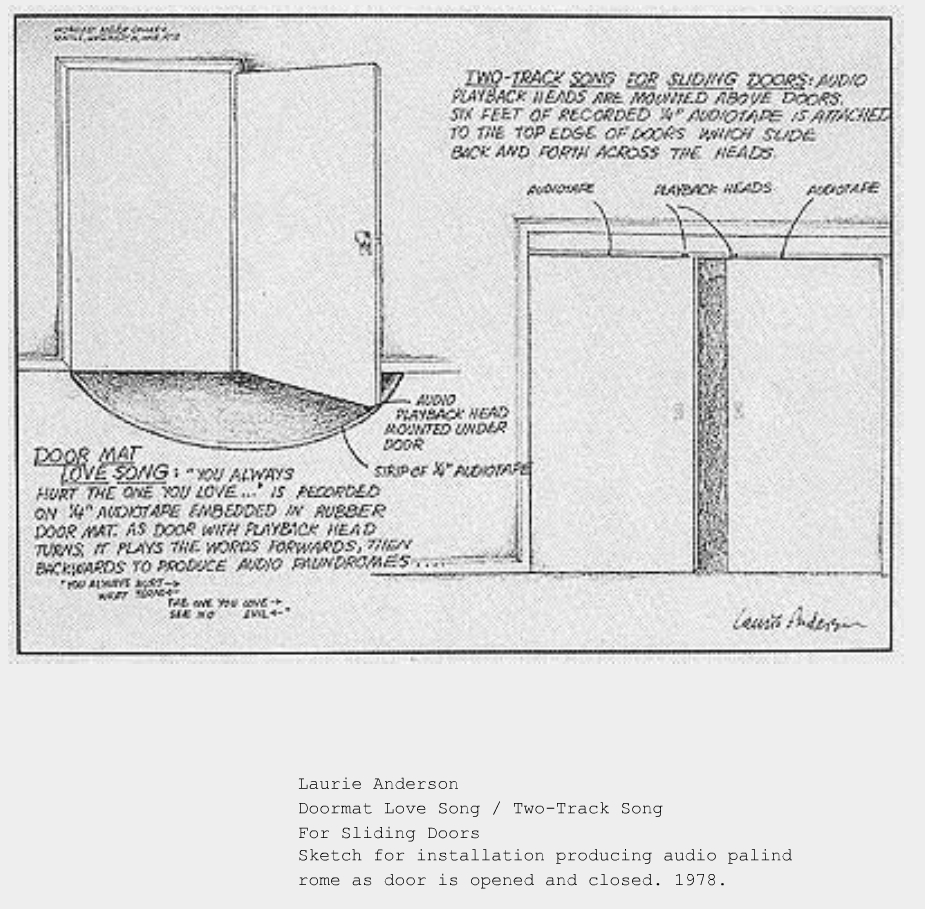 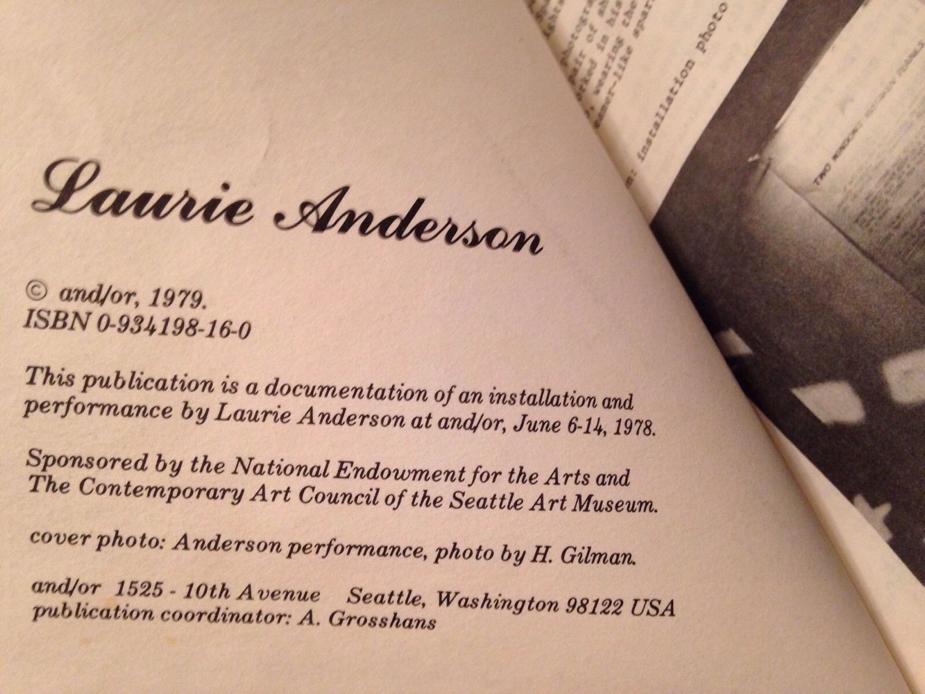 |
1978 — Three Expediences(Edit)
Three Expediencies I met a man in Canada, and every day he had the same thing for lunch He had a carrot, and he had a bowl of chocolate pudding First, he ate the carrot into the shape of a spoon, Then, he ate the pudding with the carrot shaped spoon And then, he ate the carrot I saw a photograph of Tesla, who invented the Tesla coil He also invented a pair of shoes, with sole fourteen inches thick, To Ground him while he worked in his laboratory. In this picture, he was sitting in his lab, wearing his shoes, And reading by the light of the long streamer-like sparks shooting out of his transformers | It was the night flight from Houston, near perfect visibility We could see the lights from all the little Texas towns I was sitting next to a 52 year old woman, Who'd never been on a plane before Her son had sent her a ticket and said "Mom, you've raised ten kids, it's time you got on a plane" She sat on the window seat She kept talking about the big dipper, and the little dipper And pointing Suddenly I realized she thought we were in outer space, Looking down at the starts I said "I think those are little towns" [Source] |
recorded at ZBS Media, Fort Edward, New York, Feb. 1978.
In LP: Big Ego (Giorno Poetry Systems) - BIG EGO / THE DIAL-A-POEM POETRY LP
https://www.discogs.com/fr/Various-Big-Ego/release/798090 - http://www.ubu.com/sound/big_ego.html
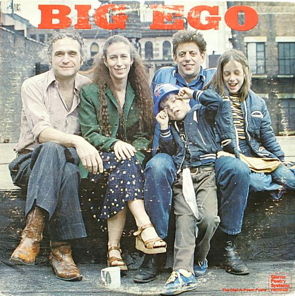
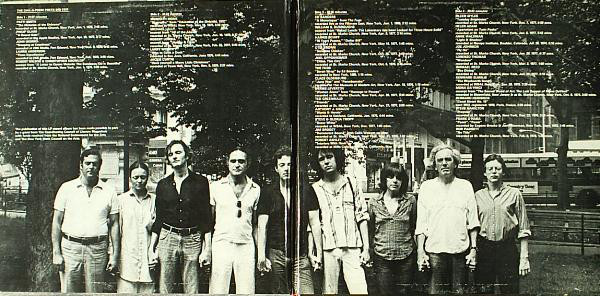
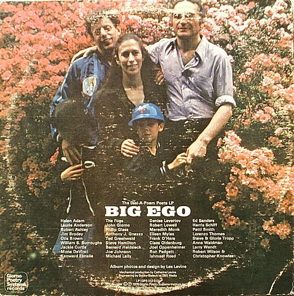
2 LPs - Giorno Poetry Systems – GPS 012-013 - "The Dial-A-Poem Poets LP" - 1978
1978 — Numbers Runners(Edit)
| Laurie Anderson’s Numbers Runners (1979) recreating a typical American phonebox, only becomes an entirely fuller proposition when the viewer picks up the receiver to hear the artists existential questions : a phone in a booth that plays back the talker's voice almost as he uses it, creating additional dialogue by interspersing recorded comments from the artist. |
| Numbers Runners est une cabine de téléphone modifiée. Il s’agit en fait d’une pseudo cabine téléphonique. Le spectateur-expérimentateur entre dans la cabine, décroche le combiné et le porte à son oreille: il peut alors entendre deux voix, celle de Laurie Anderson (préalablement enregistrée sur une bande) et sa propre voix. Le spectateur entend les mots qu’il a prononcés avec un retard (un décalage plutôt) de 0,75 seconde. Ainsi la cabine téléphonique donne la possibilité au spectateur-auditeur de participer à un dialogue avec l’artiste. Mais on comprend assez vite que ceci est un faux dialogue comme le remarque très justement Jessica Prinz : « Dans la pseudo-cabine téléphonique Numbers Runners (1978), les auditeurs deviennent locuteurs, puis de nouveau auditeurs, ainsi ils sont contraints de se confronter aux mots qu’ils ont prononcés eux-mêmes. » Le spectateur réalise qu’il dialogue avec une machine et au-delà de ça qu’il discute avec lui-même. Parler à une machine revient donc à parler tout seul et à échouer dans la communication. Certaines personnes ont cette sensation lorsqu’elles doivent laisser un message sur un répondeur téléphonique, tandis que d’autres ont la quasi conviction d’avoir un échange avec un interlocuteur. Outil de communication moderne, le téléphone peut jouer un rôle paradoxal. L’artiste montre en effet que cet objet peut court-circuiter la communication et provoquer son échec. Et comme le souligne Laurie Anderson elle-même : « La chose la plus importante est que les gens apprennent à communiquer et à se parler. Les appareils électroniques ne sont que des médiateurs. Leur efficacité dépend de la manière dont ils sont utilisés. » (Thomas Aucouturier, ÉTUDE CRITIQUE D'UNE PERFORMANCE - LAURIE ANDERSON: United States Parts I-IV (1983), 1977) |
1978 — Tape Bow Trio(Edit)
— — The Kitchen, NYC, 1978
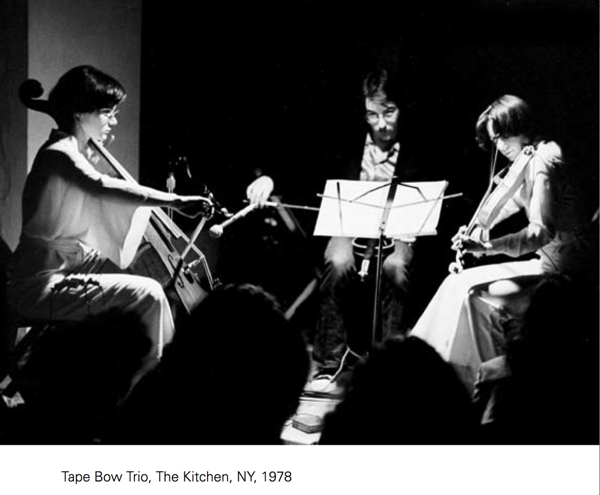 | The Tape Bow Trio : Patrice Anderson, Joe Kos, Laurie Anderson. All three instruments were equipped with both strings and audio tape heads mounted on the bodies of the instruments. |
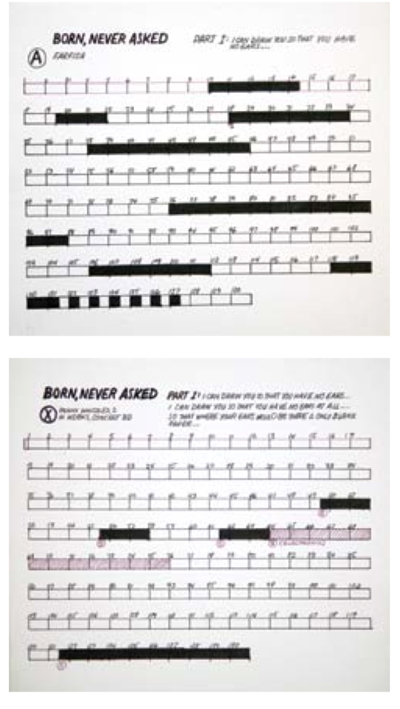

Tape Bow scores for "Born, Never Asked", 1980
Tape Bow Trio - Say Yes (1978)
From the CD The Record of the Time (Sound In The Work Of Laurie Anderson), Museum Kunst Palast – ISBN 3-9808208-8-2, cd 2003
1978 — Songs for the Night Driver(Edit)
— — an installation of slides and audio at the Wadsworth Atheneum, Hartford, Connecticut, Dec. 1978 - Jan. 1979.
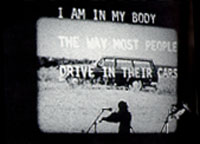 | Song for the Night Driver #3 contains the often cited passage, "I am in my body the way most people drive their cars." Laurie Anderson plugs her body into technology to produce a cyborg-like character. Here sexuality is blurred in an androgynous figure, however, this is not the bachelor machine body of an earlier modernist practice. Although Anderson announces that her body is a machine: "I am in my body the way most people drive their cars", her autobiographical scripts are allegories. The car becomes the metaphor for the unconscious. The female body-machine is commodified in a familiar way, alienated from its own subjectivity. The car as feminine subject and extended (phallic) ego is analogous with the body as vehicle. — (Ann March, In Bad futures: performing the obsolete body, [Source]) — — United States (1983) is framed, for instance, by the image of a Night Driver, windshield wipers monotonously moving back and forth before her, lost on the way home from work. Wearing goggles that light up like headlights, Anderson says "I am in my body the way most people drive their cars." The body, that is, is a more or less mechanical conveyance for the mind that it hauls around - and yet most people drive in their cars mindlessly, or a least carelessly. At the outset we are introduced to this Night Driver in a piece called Say Hello. |
Download Songs for the Night Driver presentation, Wadsworth Atheneum, Dec. 1978 - Jan. 1979 (pdf)
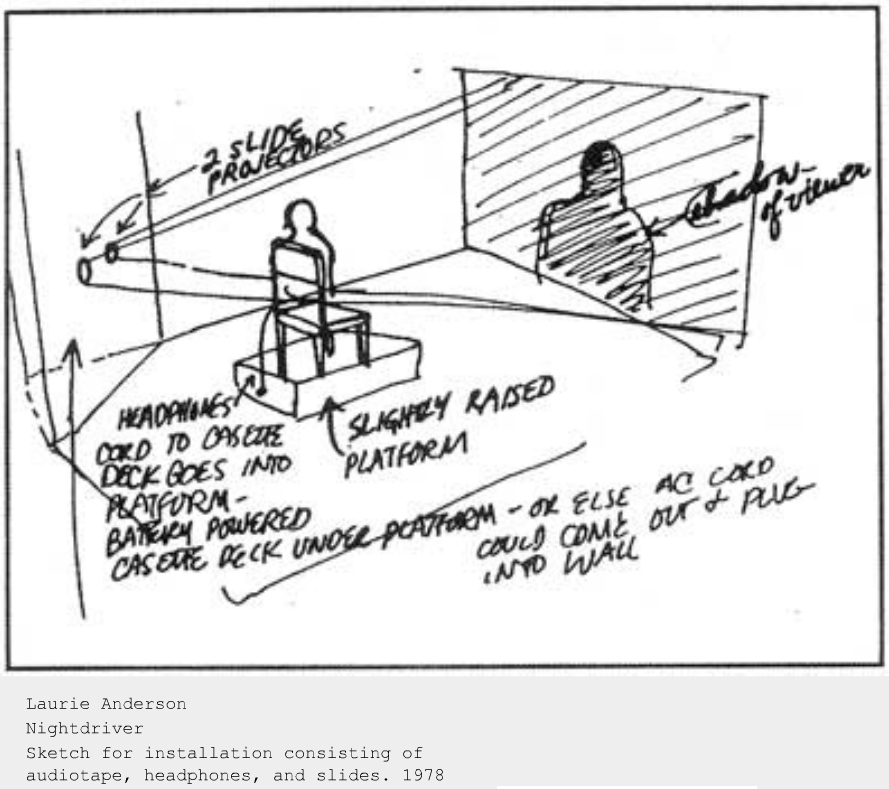
1978 — Instants - Part 12(Edit)
— — See next page : 1979 - Americans on the Move.
Notes(Edit)
Peter Gordon (composer, saxophonist, producer) first began collaborating with Jill Kroesen in 1973, when they were both graduate students at Mills College, and they have been working together ever since. Gordon has performed with his Love of Life Orchestra since 1977. He has an ongoing collaboration of video and music performances with Kit Fitzgerald, has composed four operas and numerous scores and soundtracks, and received Obie and Bessie Awards. Work with Lawrence Weiner includes films, recordings and an opera The Society Architect Ponders the Golden Gate Bridge. A frequent collaborator of the late Arthur Russell, he has been touring Arthur Russell’s INSTRUMENTALS, directed by Peter Gordon. He produced records for Arthur Russell, Rhys Chatham, Laurie Anderson, and Jill Kroesen, and was music producer for Robert Ashley’s Perfect Lives, as well as the Spanish-language version, Vidas Perfectas. Recent recordings include the retrospective Love of Life Orchestra (DFA Records), Beachcombing, with Factory Floor, and Symphony 5; and his new album with Tim Burgess, Same Language, Different Worlds will be released in September. Gordon is Professor of Music at Bloomfield College. [see Part 3 : 1975-1976] |
Scott Johnson Composer Scott Johnson has been a pioneering voice in the new relationship being forged between the classical tradition and the popular culture that surrounds it. Since the early 1980s, he has played an influential role in the trend towards incorporating rock-derived instrumentation and electronic elements into instrumental ensembles and traditionally scored compositions. His music has been presented worldwide, by performers ranging from the Kronos Quartet and the Bang On A Can All-Stars to the Chamber Music Society of Lincoln Center; in dance works performed by the Boston Ballet, the London Contemporary Dance Theater, and the Ballets de Monte Carlo, and in recordings on the Nonesuch, CRI, Point, and Tzadik labels. Recent awards include a Koussevitsky Foundation commission and a 2006 Guggenheim Fellowship. [see Part 3 : 1975-1976] |
Next Part 5 : 1979(Edit)
Pages : — — [The Handphone Table (1978)] — [Part 1 : 1971-1972] — [Part 2 : 1973-1974] — [Part 3 : 1975-1976] — [Part 4 : 1977-1978] — [Part 5 : 1979] —
Page : — — [Introduction (in French)]
